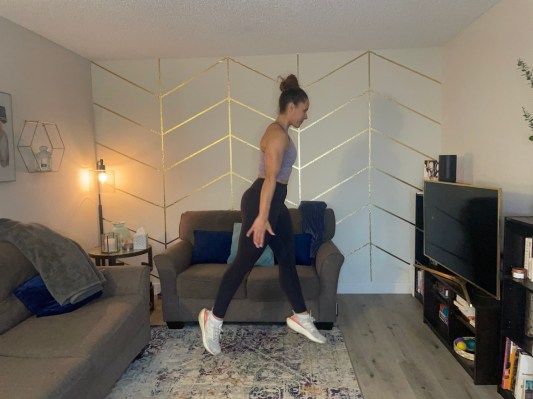Never skip a leg day! Whether you love them or love to hate them, lunges are a great exercise for building lower-body strength. They’re a functional, foundational movement that allow you to do daily activities like walk, run, skip, and climb stairs.
Overall, lunges can help to build strength, stability, and flexibility in your lower body, and with its multiple variations, the lunge should be added to your fitness routine on your next leg day.
Read on to learn more about the benefits of lunges, which muscles they work, and how to do them the right way.
How to do a lunge with perfect form every time
- Start standing with your feet hip-width apart, hands clasped in front of your chest.
- Step your left leg forward, bending both your front and back legs to a 90 degree angle.
- Keeping your chest tall, bend both knees and drop toward the floor with control. Keep lowering until your back knee is about an inch off the ground (or as low as you can comfortably go).
- Push through your left foot to bring yourself back to the starting position.
- Repeat until all reps are completed on one side or alternate your reps, stepping forward with your right leg next.
The benefits of lunges that’ll convince you to add them to your workouts
1. They build lower-body strength
Not only do lunges work the posterior (think: glutes and hamstrings) side of your body, but they also activate muscles in your core, quads, and, depending on the type of lunge you do, your inner thighs.
2. They increase balance and stability
“Because lunges are a single-leg movement, they help to stabilize imbalances and strengthen the muscles,” says Emily Jaques, CPT.
They not only require lower-body strength, but also core strength to help keep you balanced.
“Lunges are a great way to build stabilization strength and increase control within the ankle muscles,” says Aryana Shokat, CPT. “As you take a micro-pause between lunge steps, the back heel is in a raised position, which forces you to activate all the ankle stabilizers, which often get weak. When the stabilizers weaken over time due to misuse, we are more prone to accidents like falling due to the lack of control and strength in the foot muscles.”
3. They increase flexibility
Because there are so many variations of lunges, they’re great for increasing your flexibility. Outside of the traditional forward and reverse lunge, there are additional variations that allow you to increase range of motion in lateral directions and challenge your depth, Shokat explains.
“Aside from weighted lunges, there are various lunge stretches that allow the body to deeply open up the quads and hamstrings, which often are tight muscle groups for many people,” she says.
4. They don’t require any equipment
One of the best things about lunges is that you don’t need to add weight for them to be challenging, Jaques says. Though you can add resistance, doing them with your body weight works just as well. This also allows you to be able to do them anywhere: hotel rooms, airports, your kitchen… all the world’s a gym.
“Get creative and vary the different types of lunges into your workouts so your body can receive the maximum strength, flexibility, and conditioning effects they offer.” —Aryana Shokat, CPT
Switch things up with these lunge variations
1. Reverse lunge

- Start standing with your feet hip-width apart, hands clasped in front of your chest.
- Step your left leg backward, bending both your front and back legs to a 90-degree angle.
- Keeping your chest tall, bend both knees and drop toward the floor with control. Keep lowering until your back knee is about an inch off the ground (or as low as you can comfortably go).
- Push through your right foot to bring yourself back to the starting position.
- Repeat until all reps are completed on one side or alternate your reps, stepping backward with your right leg next.
2. Lateral lunge

- Start standing with your feet hip-width apart, hands clasped in front of your chest.
- Shift your weight to the left and step to your left with your left leg.
- Bend your left knee and shift your hips back, keeping your right leg straight.
- Push off of your left foot to bring yourself back to the starting position.
- Repeat until all lateral lunge reps are completed on one side or alternate your reps.
3. Static lunge (split squat)

- Start standing with your feet hip-width apart, hands clasped in front of your chest.
- Step your right leg backward, bending both your front and back legs to a 90-degree angle.
- Push off of both feet to straighten your legs.
- Bend both legs again until they are at a 90-degree angle.
- Repeat until all reps are completed on the right side, then complete on the left side.
4. Alternating jump lunge

- Start standing with your feet hip-width apart, hands clasped in front of your chest.
- Step your left leg forward, bending both your front and back legs to a 90-degree angle.
- From this position jump off of the ground and land with your right leg forward and your left leg backward in a 90- degree angle. (You can extend your arms down along your sides as you do.)
- Continue to alternate until all reps are complete.
Which muscles do you work when doing lunges?
Lunges are a functional movement that activate and strengthen your entire lower body. The muscles you will feel light up include your quadriceps, glutes, hamstrings, calves, ankles, and core.
Safety tips to keep in mind during lunges
If you struggle with your balance, find a stable surface to use as a support. Try using something to hold on to, like the back of a chair, a door frame, or TRX straps to help you nail the movement, Jaques suggests. You could also do a static lunge instead of moving lunge if balance is a challenge.
Some people feel pain when they lunge, so trying a wider stance or reducing your range of motion may help with that.
“If there’s any knee pain or inflammation due to a current or residual injury, reduce the depth of the lunge and only drop the knee to a depth that feels comfortable at the knee joint,” Shokat says.
If that doesn’t work, don’t continue lunging and check in with your healthcare provider. (FYI: It’s a good idea to chat with them before you start incorporating lunges into your fitness routine, too, just to make sure you have the green light.)
FAQ
1. How many times a week should you do lunges?
Lunges can be a part of your everyday workout routine. The great thing about lunges is that there are many different ways to perform them, so you can do a different version each day.
“Get creative and vary the different types of lunges into your workouts so your body can receive the maximum strength, flexibility, and conditioning effects they offer,” Shokat says.
Jaques suggests incorporating squats into your lower-body days two to three days a week for variation, but if you’re doing your lunges with your body weight, you can do them daily.
2. Is there anyone who shouldn’t do lunges?
While lunges are generally safe, there are a few groups of people who may not want to perform them.
Because lunges challenge your stability, Shokat suggests either limiting or removing forward lunges from your routine if you’re in the third trimester of a pregnancy. “It becomes more of a danger to fall forward, potentially injuring the baby,” she says.
Other populations who many want to be careful when it comes to lunging, are those with a limited range of motion in their ankles, hips, or knees. “It might be a good idea to work on mobility first, maybe with a trainer or a physical therapist, to ensure that if and when you do lunge, it can be done safely within your range of mobility and capability,” Jaques says.
If you have a history of chronic knee pain or are coming back from an ankle injury, you may also want to talk to your doctor or trainer about attending physical therapy before adding lunges to your fitness routine. If former pain or injuries are present, lunges can often be an exercise that does more harm than good, Shokat says.
3. Are lunges better than squats?
Lunges and squats are excellent lower-body exercises and have some of the same benefits. Both exercises are great compound strength-building moves, Shokat says. However, she adds, there is a huge group of the population that struggle with squats due to prior injuries in various parts of their body.
“Often I find that clients are able to add lunges into their routine more often [than squats] and free of pain. Although there is a great amount of squat variations, there seems to be equal or an even greater amount of lunge variations for us to play around with. So, strictly speaking on the general population’s ability to perform this movement more often, with greater ease, on top of all the variations out there, I will say that lunges have a slight edge over squats.”
Outside of the ability to perform each exercise, Jaques says that as far as importance, the squat and lunge are equal.
“Weighted or not, they’re a staple for the lower body,” she says.
